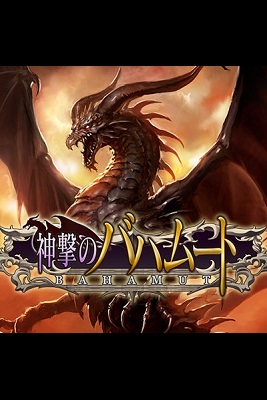Rage of Bahamut (2011/2012)
[神撃のバハムート]

Publisher: DeNA
Developer: Cygames
Platform: Android/iOS
Overview:
A knight with extraordinary abilities is dispatched to combat the various ills plaguing the world.
Gameplay:
The core gameplay is a lot like Cinderella Girls and I imagine CG drew heavily from this game when setting up its model. This is a card battler divided into three factions: Man, God, and Demon, with basic stats modified by the various individual abilities of the different cards. Cards are ranked N, HN, R, HR, SR, SSR, LG, and SLG. You can merge cards from two to four times and five-star certain high-level cards. While the cards have their levels (leveled up by consuming other cards), you the player also have your own level, which influences how much stamina you have and the max cost for your offensive and defensive decks. Besides leveling, you get upgrade points from completing quests and adding friends.
It would seem that the original game's questline was just a simple tap-based game, but at some point they made a new questline more like a typical turn-based JRPG using petit charas with one of five elemental alignments (fire, water, wind, light, and dark). Besides simply leveling the petit charas in battle, you can boost their stats by joining them with cards from your inventory and Demon Crystals for various abilities. The Demon Crystals can be leveled, merged and augmented with additional abilities.
While regular quests rely on stamina, the multiplayer relies on BP. You go up against other players' decks and gain rank through successive victories as well as crystals you can take to the alchemist for various rewards. The first few battles each day give you participation points regardless of whether you win or lose, so this can mitigate unbalanced matchups.
There are a number of different kinds of in-games currency used for various reward exchanges, plus a gacha that has both free and premium tracks. There is also a marketplace for trading cards, where you need both voucher tickets and whatever the auctioneer is asking for a given card. I believe you can also gift cards, items, etc. to people in your friends list.
It would seem that they haven't put much effort into quality-of-life updates, things like facilitating navigation through your inventory, expanding inventory capacity, etc. For me, the deal-breaker was capping out my inventory to the point where I couldn't really do anything. There are over 5000 individual cards, but little more than 700 slots in a fully expanded inventory. Since I was trying to fully upgrade cards before discarding them, I hit a brick wall and rather than just start throwing away cards I wasn't finished with, I just deleted the game. Yes, that's more a matter of my personal idiosyncrasies, but I have a feeling a number of people drawn to this sort of game would have a similar reaction.
Story/Characters:
The old questline only has minimal flavor text to give some context to what would otherwise be mindless tapping, but the new questline at least has a proper story. It's fairly boilerplate for JRPGs but there are some decent character dynamics. The event quests tend to be a little more entertaining from the couple I went through. There's a huge cast and while many will fall into set archetypes, those that get proper development do have some nice depth to them.
Graphics:
The core interface is fairly basic and the effects add a little pop to what would otherwise be static card battles. For the petit chara quests, the petit chara models are simple while the enemies use their card illustrations, leading to some amusing dissonance in style. The main visual feature is the cards themselves. The many illustrators range in quality from being outstanding to fairly blah. You may or may not appreciate that upgrading cards (namely female characters) tend to result in successively more revealing costumes. Usually the art has fairly minimal changes, only to give you completely new art for 5-starred SLGs.
Music/Sound:
The music does its job well enough, but because there's no volume control, I ended up just muting it. Sound effects similarly do their job without being outstanding. The voice acting, on the other hand, is pretty good with a number of high-profile seiyuu in the cast. Not all cards are voiced, but the cutscenes in the new questline and the event quests are.
Conclusion:
This is a decent card battler hobbled by an archaic interface and declining support from the developer. I ended up giving up on it because it thwarted my collector's instincts, but while I was playing it, I enjoyed it well enough. Though English support was suspended back in 2016, if you feel like accessing the Japanese version, you might enjoy it. I have a feeling it would've been better back in its heyday, but consider giving it a shot.
Rating:
Play It
